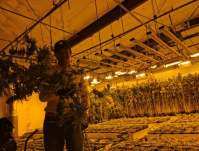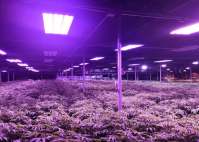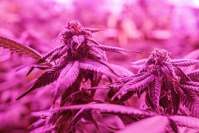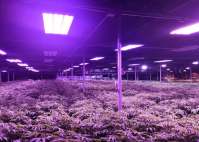Nowadays, the LED grow light market is still mainly concentrated in a few countries and regions such as Japan, the United States, and the Netherlands. Europe: It accounted for 35% of the global LED grow light market in 2017 and continues to grow. Many European countries actively promote plant factories and provide subsidies to stimulate local demand. North America: Many start-up farms and food suppliers have been using LED grow lights to cope with weather obstacles, and long winters and short sunlight have always been a limiting factor in agriculture.
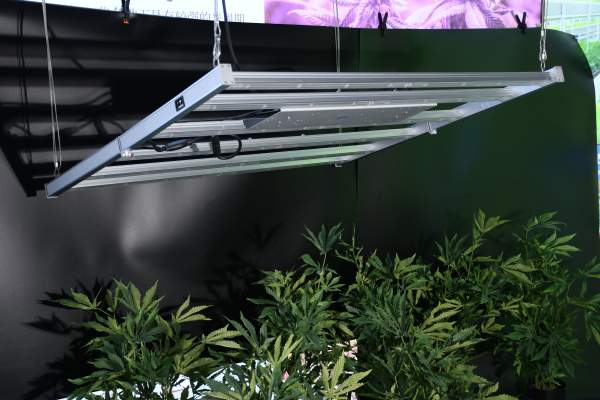
The development process of my country's LED grow light industry is relatively slow, mainly due to the low input-output ratio of domestic plant factories and the high price of output products. However, the high-efficiency and energy-saving characteristics of LED grow lights represent the future development direction of green agricultural lighting. It is extremely widespread in the field of planting and has received strong support from the domestic agricultural sector, and the foreign market is even hotter.
By application: Plant factories lead the demand. LED grow lights are widely used in the field of plant cultivation, including plant tissue culture, leafy vegetable cultivation, plant factories, seedling factories, edible fungi factories, algae cultivation, plant protection, flower cultivation, etc. Many terminal applications nowadays are professional plant factories and greenhouse growers who are gradually replacing HID.
Reasons for the booming LED grow light market:
Legalization of medical marijuana in North America
The medical value of marijuana has been fully academically proven, and its multiple effects can fight a variety of diseases. Hundreds of special compounds (collectively referred to as "cannabinoids") have been found in cannabis, of which THC and CBD are the main cannabinoids. According to the THC content, hemp can be divided into industrial hemp (<0.3%), intermediate hemp (0.3%~1%), and recreational hemp (>1%). Among them, medical marijuana can help increase appetite and relieve the vomiting symptoms of AIDS patients and patients during chemotherapy; it can help patients suffering from insomnia, mental stress, and chronic pain. Cannabis can be used as an effective anti-inflammatory drug and has curative effect on epilepsy and Tourette's syndrome.
The global legalization of cannabis medical marijuana continues to advance. Israel is a pioneer country in allowing marijuana medical use worldwide, and in 1996 it formulated a national plan focusing on medical marijuana. On November 26, 2018, South Korea became the first country in East Asia to legalize medical cannabis. From 2019 to 2018, Canada, Uruguay, Australia, Germany, Thailand, and the United Kingdom have successively legalized medical marijuana. As of January 2019, 34 countries around the world have declared medical cannabis legal, and more than 50 countries have declared CBD legal.
With the gradual lifting of upstream restrictions, the medical marijuana market welcomes strong growth. At the end of 2018, the United States passed a new farm bill to legalize the cultivation of industrial hemp at the federal level. The North American hemp market rapidly expanded. In 2019, the legal cultivation area of industrial hemp in the United States surged to 453,000 acres, an increase from 78,100 acres in 2018. 479%. According to NewFrontierData data, the size of the US legal cannabis market will increase from USD 13.6 billion to USD 29.7 billion in 2019-2025, with a CAGR of 13.90%; the medical marijuana market will increase from USD 6 billion to USD 13.1 billion with a CAGR of 13.89%.
The downstream application space of industrial hemp is vast, and it is expected to penetrate into more fields in the future. At present, Coca-Cola, Pepsi, Red Bull, Nestle and other companies have publicly announced that they will develop and use industrial hemp.
Increase in population and decrease in arable land
Over the past 60 years, global population growth has been in sharp contrast with the decline in per capita arable land. From 1960 to 2019, the global population increased from about 3 billion to 7.7 billion. From 1961 to 2018, the global per capita arable land area fell from 0.36 to about 0.18; my country’s per capita arable land area fell from 0.16 to 0.09.
With the continuous advancement of urban construction, problems such as the reduction in the proportion of agricultural land in developed countries have emerged. The current proportion of agricultural land in the United States, the United Kingdom, France, Germany, and South Korea has all declined by about 4-10pct compared with the 1960s. According to the 2017 revised report of the United Nations "World Population Outlook", the world's population is expected to reach 8.6 billion in 2030, 9.8 billion in 2050, and 11.2 billion in 2100. Existing cultivated land design still cannot avoid the ultimate contradiction of limited cultivated land area. However, vertical agriculture can be extended vertically in space, and population growth will become the most important growth driver for vertical agriculture/plants.
Vertical agriculture has greatly increased the yield of crops per unit area. The plant factory rack can be as high as more than 10 layers. For example, Nordic Harvest, the largest farm in Europe, is equipped with 14-layer racks. The plant factory can harvest 15 times a year on average. Compared with traditional planting, it can greatly increase the yield of crops twice a year. The basis of all this is that LED grow lights are needed to complete. Therefore, the market demand for LED grow lights is at the same time as the development of vertical agriculture. Expand further.
Vertical agriculture can reduce costs and increase efficiency in multiple dimensions such as distribution and water resource utilization. Vertical agriculture can be located in urban centers to achieve shorter food miles, isolate from pathogens, reduce soil degradation, and recapture and recycle nutrients and water. The agricultural products of vertical agriculture are more consistent and stable in price, and they are grown in regions with harsh climates (such as deserts or the Arctic). As indoors, vertical farms can "perfectly fine-tune" all conditions through LED grow lights to maximize productivity, making investment in basic biological research play an important role.
Through the above understanding of the booming LED grow light market, more and more companies are engaged in the field of plant lighting. The various LED grow lights produced by Yaorong Technology are highly recognized by users. On the road of future development, we will always insist on producing good products to help more plant cultivation become more efficient and reliable.


